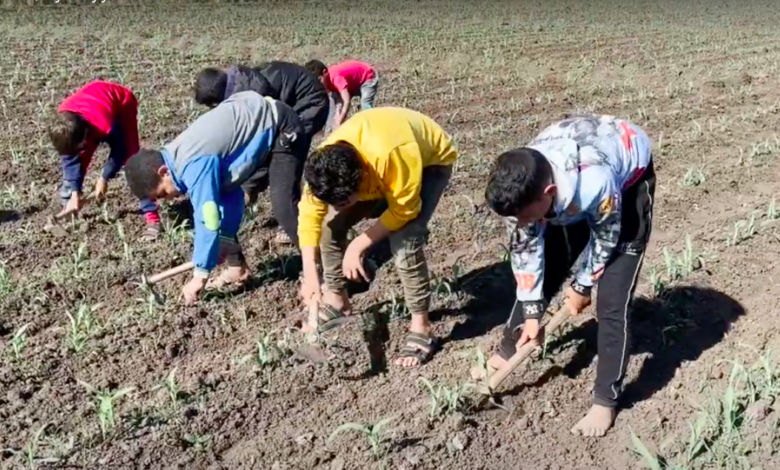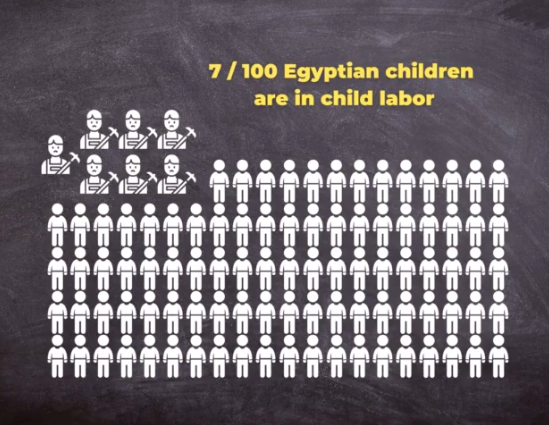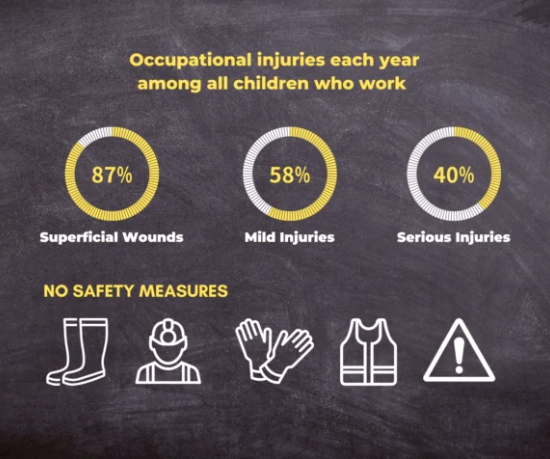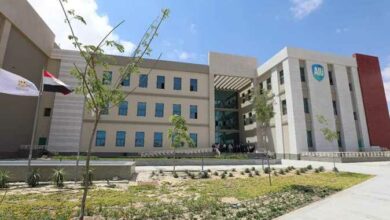
Ibrahim is only nine years old, and already his skin is stained black with motor oil. His untrimmed nails carry the grime of the endless laborious hours he works.
Vast kilometers away from his family, who reside in al-Mahalla al-Gharbia, Ibrahim battles fatigue to leave his bed at seven am in Cairo. But Ibrahim isn’t like your average little boy, packing a superhero-adorned pencil case and impatiently waiting for the yellow school bus to arrive.
No, little Ibrahim’s destination is an automobile repair shop – his job.
In al-Herafeyeen, al-Salam, Ibrahim finds himself in a cacophony of bustling workplaces, where supervisors yell orders and machines whir louder than his tiny voice can speak.
His fingers wrap around harsh metal tools as he learns the ins and outs of repairing the massive bodies of vehicles. Other children his age spend hours eagerly driving them in front of big screen TVs through video game controllers, without a care in the world.
However, being a school dropout, Ibrahim must work. And work he does, spending more than 12 hours crammed in the shop, never leaving as he came.
His jeans, once fairly clean, are now always specked with stains, and his once vibrant face laced with exhaustion.
A cyclic pattern, his days go on like clockwork. He only ever reunites with his family on the four-day break he manages to cram into two lengthy months of work.
Ibrahim is just one of many children stripped away from the very thing that defines them: their childhood.
He is a victim of child labor.
According to the International Labor Organization (ILO), child labor is defined as “work that deprives children of their childhood, their potential and their dignity, and that is harmful to physical and mental development.”
Despite the clear negative connotation, statistics only speak of its prominence.
In 2021, child labor increased to 160 million on a global scale, according to Unicef.
The ILO estimated child labor in Egypt to have reached 1.8 million children starting from the age of 12 in 2017. This number is expected to be exponentially higher considering the informal and sensitive nature of this issue, especially after the unexpected global pandemic of COVID-19, which sent Egypt into yet another economic spiral.
With no tourism to support the country’s economy, “The crisis accounted for around 12 percent of GDP, 10 percent of employment, and four percent of GDP in foreign currency earnings,” according to the International Monetary Fund.
Chasing Piasters
Egypt is the 14th most populous country in the world, according to the Central Agency for Public Mobilization and Statistics (CAPMAS).
With so many people living in the same country, overpopulation is an inevitable issue.
“The overpopulation problem in Egypt is four-dimensional,” said assistant professor in the Faculty of Medicine in Qasr al-Einy in the gynecology department Amr Hassan, and the previous rapporteur of the National Population Council.
He clarified that the main factor was the disparity between the population and the available resources.
Hassan explained that demographic qualities like health, education, and literacy deteriorate when population size rises. Other factors include the population’s concentration in just 14 percent of the total Egyptian territory and the country’s widening economic gap.

Overpopulation is what determines the correlation between poverty and child labor, as it has placed strain on Egypt’s economy and resources resulting in widespread poverty.
The country’s economy struggles to keep up with the rising demand for basic necessities like food, housing, and healthcare.
As reported by CAPMAS, the poverty rate in Egypt has been surging since 2016, with over 29.7 percent of the population living below the poverty line.
Yet Egyptian families continue to have more children despite the country’s persistent economic crisis, forcing them to work so the family can survive. Based on Macrotrend’s latest statistics, Egypt’s population growth rate is 1.92 percent, substantially greater than the 1.04 percent global average.
“I must work to eat,” Ibrahim said, detailing the all-too-common reason he is working so long.
“We are a family of eight: my mom, my dad, and my five siblings, three girls and two boys. My two elder brothers were the only ones who got to go to school, while the rest, including myself, couldn’t. My father is not a thief. He cannot afford to spend on a big family like us.”
Earning 30 pounds a day, Ibrahim dedicates only a third of his salary towards his own spending, which is free of any luxuries, only the necessities that would fuel him to manage through yet another day.
The rest goes to his family in hopes of sustaining their growing household.
A Problem of Legislation or Implementation?
The constitutional minimum age for employment is 15 years old – as per Article 64 of the Egyptian child law, child labor is prohibited in the country.
The legislation prohibits children from working in any hazardous jobs including those that are physically or morally detrimental, or that interfere with a child’s health or education.
Children of this age are known as “sibiya” and usually have subsidiary jobs.
According to the ILO convention #138, the minimum age for employment is 15, with the possibility of setting the general minimum age at 14 for countries with underdeveloped economies and educational systems.
While Egyptian law protects children’s rights to education, the constitution states that education is obligatory for Egyptians until the preparatory stage (14+ years old); after that, children are free to choose whether they want to continue their education.
The Egyptian law follows the aforementioned ILO convention.
However, there are several conditions on the matter, according to labor lawyer Saied Abdelrabou.
“Children cannot work more than six hours in the morning. They must be provided with a safe working environment, and most importantly, a working child must have an official contract that is signed by their guardian to ensure consent and to protect the child’s rights,” he explained.
Ibrahim’s parents decided to send him all the way from al-Mahala to Cairo to hunt for employment because of the mounting costs and obligations of the family.
“I visit them once every two or four weeks, depending on what the Usta decides,” Ibrahim said as he wiped the sweat off his dripping forehead.
According to Abdelrabou, specific committees within the Labor and the Social Affairs Offices safeguard the working children’s rights regarding wages and insurance and ensure that their jobs are not putting their lives at risk.
He referred to what he thinks is hindering the elimination of the child labor prevalence, which is the lack of execution of the laws.
“The laws are there. They are explicit and direct. Whenever child labor violations are reported to the police, appropriate actions are taken that could result in fines, warnings, and even the closure of a business. The problem lies in the insufficiency of inspections regarding this phenomenon.”
Battling for an interview
To learn more about the life of working children, it was a struggle to win the consent of child employers in various areas in Cairo. They believed the interview was part of an ongoing investigation by the United Nations. One of the numerous ways used to persuade Mostafa, the owner of an automobile repair shop with four children working for him, to agree to an interview was promising not to record it.
“Why wouldn’t they find me using my voice if the government wanted to? They certainly would. Miss, it’s the government!” Mostafa said.
After a lengthy casual conversation with Mostafa, he revealed that shop owners always ask children to leave the workplace whenever one of the governmental committees is conducting an inspection in the area, fearing the repercussions.
Social Enablers
Child labor in Egypt takes on various different forms and degrees of intensity. Children could be found working for many different reasons and their experience encompasses a wide array of conditions. This includes agriculture work, such as farming and tending livestock, to industry work, such as carpentry workshops and making bricks.
Atef, 12, is responsible for his aunt’s spice shop. He opens the store at eight am, manages customers, operates the cashier, and finally closes the shop at four pm. Ahmed, 10, on the other hand, only helps his dad at his automobile repair shop on the weekends.
Both have one thing in common: enrollment in a public school.
“I’m not like you; I go to school. I understand what they’re trying to do,” Ahmed told Ibrahim, taking pride in his education, thinking this interview was for a larger scheme.
With school spanning from the early mornings to the afternoons, it is only possible that children engaging in both would have to sacrifice their full commitment to one.
Atef explained that he only attends school once or twice a week in order to help out his aunt, who only trusts her own family members to handle her work.
“I get an excuse from the principal that I work so I can skip classes,” Atef explains, highlighting how the education system enables him to prioritize his work over his education.
National Project Manager at ILO, Marwa Salah-Abdou, explained that the Egyptian constitution states that education is obligatory for Egyptians until the preparatory stage (14+ years old); after that, they are free to choose whether they want to continue their education.
Children in Egypt don’t necessarily view their job and the concept of work as something that is solely defined as a burden. According to Atef, “Al-san’aa” or learning a skill in the labor force, is essential to have whilst growing up because of the possibility that an educational degree will not land him a job.
“If I have a skill, I can apply it anywhere,” he said.
Atef believes he’d encourage his own children to follow in his exact same footsteps, starting work early on.
But with the naivety of children, they may not have the necessary tools to recognize child labor as the problem it is.
Parents, families and the overarching culture seem to push for and support the idea of children working for their living at such a young age. The cultural mistake of classifying a working child as an independent adult causes children to become oblivious to their basic needs.
While unraveling the societal outlook on the issue in al-Herafyeen, Rana Abdelhamid, who was repairing her car at Mostafa’s shop, told us, “I don’t see it in a negative way. Life is tough, and if a child is working to help his family survive, then he was raised in a good way. This is how he becomes a man.”
Sharing this same opinion, Mostafa was defensive towards accusations of his employment of children, claiming they were the ones in need of him.
“It’s better than finding them on the streets, doing drugs or begging for money,” he said.
A Glimmer of Hope: Promoting Justice and Protecting Children’s Rights
The Egyptian government has made clear it holds strong political commitment to combating child labor. This is based on recent progress toward the welfare of children and the protection of children from child labor.
Egypt has set a national strategy in 2019 to combat its prevalence, dubbed the “National Action Plan to Combat the Worst Forms of Child Labor and Family Support in Egypt (NAP),” which is a collaborative coordination between the Egyptian Ministry of Manpower and the ILO.
The NAP establishes specific timelines and roles for Egyptian government agencies to help children involved in child labor break free from the cycle. The action plan, slated to be completely implemented by 2025, is in line with Egypt’s 2030 Vision of a sustainable renaissance in improving the country’s quality of life.
Salah-Abdou explained that Egypt did not have a solid legislative framework for child employment – and this is where the role of the ILO came into play.
“The ‘Egyptian Legislative Framework Regarding Child Labor’ is a section in the NAP dedicated to clarifying the laws and avoiding uncertainties when it comes to what the law has to say,” she stated.
The NAP’s objectives include enhancing access to available financial services, increasing social protection and improving access to community schools.
The project also precisely documents the impact of COVID-19 on children and child labor in cotton cultivation, through studies on how to best direct project activities towards supporting the elimination of child labor while more sustainably supporting child laborer families.
The ILO’s projects continuously work on addressing the root causes of child labor by creating interventions for different parents throughout Egypt.
Its main goal is to raise awareness about the risks of child labor and convince parents and guardians not to allow their children to work below the legally accepted age. The project not only informs but ensures the families are monitored as a way of guaranteeing that the children remain safe.
In celebration of rescuing the last group of a total of 1,500 children from child labor and reintegrating them into the educational system, the “Supporting Children’s Rights through Education, the Arts and the Media” (SCREAM) program organized a graduation party for the children and their parents in Al-Fayoum in March.
The event was supported by different government officials, representatives from Al-Azhar and priests gathered to commemorate the rebirth of hope in the lives of those families.

“The International Labor Organization is enjoying a louder voice today,” Salah-Abdou said.
She explained that among the challenges faced by the ILO in implementing the national strategy is changing the deep-embedded behavior of favoring personal benefits over societal welfare.
“People would tell us what’s in it for me?”
However, she said that there is a real improvement in the level of transparency of the Egyptian government’s acknowledgment of the problem.
The Egyptian Ministry of Manpower and the National Council for Childhood and Motherhood have both been contacted for an interview to acquire more information about governmental efforts to end this phenomenon, but did not respond for comment.
What Do Religions Have to Say?
Given that 90 percent of Egyptians identify as Muslims, to say that Islam plays a key role in Egyptian society would be underselling it.
According to “Dar Al-Iftaa,” the Egyptian Islamic advisory, judiciary and governmental body, Islam criminalizes the employment of minors because the physical and psychological structure of a child does not enable them to work.
And while work in general terms is enough to cause such harmful implications adding up most of it is included in hazardous environment.
Hazardous work environments range from long labor-intensive work in agricultural fields, to child pornography and modern slavery. The extent to which working children experience these conditions outnumbers those that are able to manage their physical and mental well-being.

Together with the Ministry of Manpower and the ILO, Dar Al-Iftaa is one of 17 partners who contributed to the NAP in an attempt to fight the issue.
“We try to restrict the perpetuation of this phenomenon through Friday sermons all over the country with a greater focus on rural areas where child labor is prevalent,” Azhar Sheikh Mohammed said.
Christianity, while partially in agreement with Islam, poses specific concerns that blur the lines between what’s religiously and morally legitimate or not.
“There’s the easy answer and that is, of course, Christianity and the Coptic church in Egypt condemn the active work of children,” said Coptic monk and theologian working for the School of Alexandria Seraphim al-Baramosy.
When it comes to Egypt’s harsh circumstances regarding social inequity, poverty, and the overall declining economic state that pushes these kids into work in the first place, his answer becomes a bit more vague.
In Seraphim’s perspective, the idea of child labor intersects with the real-time effects of the current situation of the nation, making it a harder moral question that needs deeper questioning to reach a clearer answer.
What’s Next?
Although potential plans to resist child labor are in action, their effectiveness remains uncertain.
Salah-Abdou confirmed the enactment of surveys by the ILO this year to determine the most up-to-date statistics regarding the dilemma of child labor in Egypt.
Whether these statistics will present an increase or decrease in number is still unknown, but such findings will reveal whether governmental and international efforts are sufficient, or if economic pressures are simply too severe.




